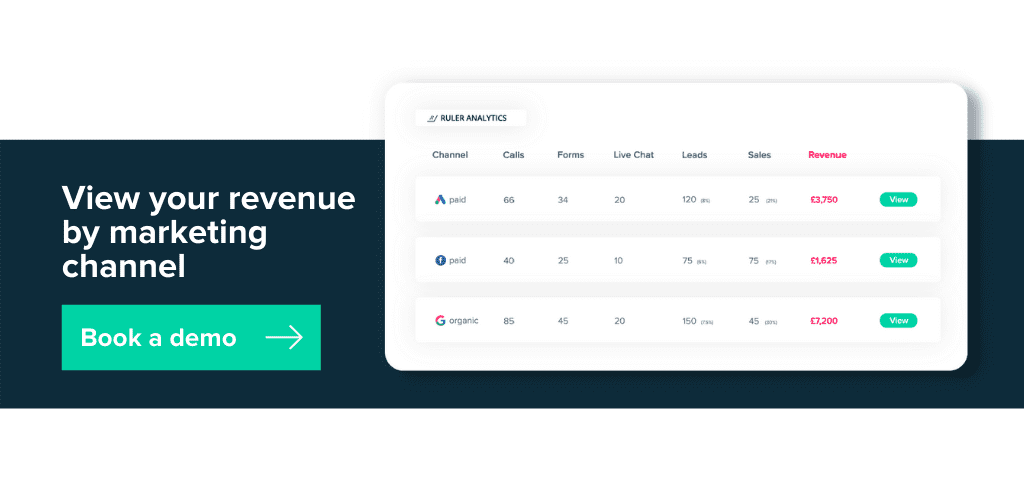Marketing attribution is an absolute must for marketers looking to get more out of their efforts. We wrote an all-encompassing guide to marketing attribution to help you get started and kickstart scaling your business with data.
We found that 58% of marketers currently use a marketing attribution tool. According to Think with Google, this will rise to 78%.
And we’re not surprised. If you struggle to report on your marketing impact, well, you’re not alone.
While metrics like clicks, likes and impressions might be easy enough to make note of, many marketers struggle to report on how marketing impacts their bottom line. In fact, only 23% of marketers are confident they’re tracking the right KPIs.
Marketing attribution is the perfect solution for those marketers struggling to connect the dots between their hundreds of marketing touchpoints and a closed sale.
Here, we share the ultimate guide to marketing attribution. You’ll learn:
Keep reading to get started with marketing attribution.
🎓 Pro Tip
Want to learn more about attribution? Well, we’re the experts so we put all our knowledge into one free e-learning platform.
Enrol in Attribution Academy today
Table of Contents
Marketing attribution can be defined best as the science behind understanding which marketing channels and campaigns are driving the most revenue.
Marketing attribution tools work to analyse and track marketing touchpoints that a user interacts with that influences their path to purchase.
Attribution will automatically credit influencing channels, campaigns, ads and keywords so that you can see which are working best to drive your bottom line.
The goal of marketing attribution is to give marketers simple data that confirms what’s working, and what isn’t.
This allows marketers to optimise their efforts and drive more revenue through marketing campaigns. Using attribution leads to higher return on investment, lower costs and more efficient work.
🚀 Pro Tip
Learn even more about attribution with our complete guide. It’ll break down exactly how it works and what it means so you can better understand how it supports your business goals.
Marketers have a hard time proving their worth. Think about your monthly reports. You likely get asked what your return on investment is. And we’re not surprised. ROI is the best metric to understand how your marketing impacts your business.
But it’s not always easy to obtain.
Related: How to track your marketing ROI
Generally, your reporting metrics might include:
You could be taking it one step further and looking at your lead generation. These metrics could include:
The simple truth with both sets of metrics is that they’re vanity metrics. On their own, they mean very little.
Related: Vanity metrics vs actionable metrics
Something very key is missing from these lists of metrics. Revenue.
Are you proving how much revenue your marketing campaigns are bringing in? While you might be able to partially prove impact, there’s simply too much data to do it completely.
This is where marketing attribution comes in.
Marketing attribution allows you to assess every channel and campaign. You’ll get a true understanding of how your content works together to form buyer journeys. And from there, you can create data-driven decisions to allow you to optimise your campaigns.
🚀 Pro Tip
Want mind-blowing statistics on marketing attribution? Download the marketing attribution analysis to unlock key challenges and insights to enhance your attribution reports.
So why is marketing attribution important? Well, we’ve listed exactly why it could be beneficial to your business:
Not sure you’re spending your budget where you need to? It can be a lot of pressure to dictate where you’re going to put your budget.
If you don’t get a suitable return, it could hinder your ability to get a budget in the future. But, with marketing attribution, you can get a real insight into how best to spend your marketing dollars. You’ll be able to see which channels and campaigns have worked best to drive sales, but also which have worked well to drive users down the buyer’s journey.
Related: How to optimise your marketing with Ruler Analytics
With real insight into your budget, comes increased ROI and ROAS.
🚀 Pro Tip
Learn exactly how you can improve your return on ad spend using Ruler. You’ll learn how to cut costs on paid ads while improving your performance. That’s more revenue, not just more clicks or leads.
With attribution in place, you’ll be able to see, in real-time, which ads and campaigns are working best. You can then just turn them on, off, or add more budget. Attribution will allow you to reach the right person, at the right time, with the right message.
Related: Learn more about revenue attribution and how it works
Evidencing what works in marketing isn’t easy. There are long customer journeys, multiple touchpoints, and multiple conversion types to consider. But with marketing attribution, you can definitively show your campaigns are generating quality leads and revenue.
This means your marketing department will be taken more seriously within the business as you start to talk about the metrics that matter in the boardroom.
Attribution tools allow you to track each and every lead plus each touchpoint they have with your website and content. And if you’re using a tool like Ruler, all of that data will be automatically stored and managed, giving you what you need where you need it most.
Related: Everything you can see in Ruler Analytics
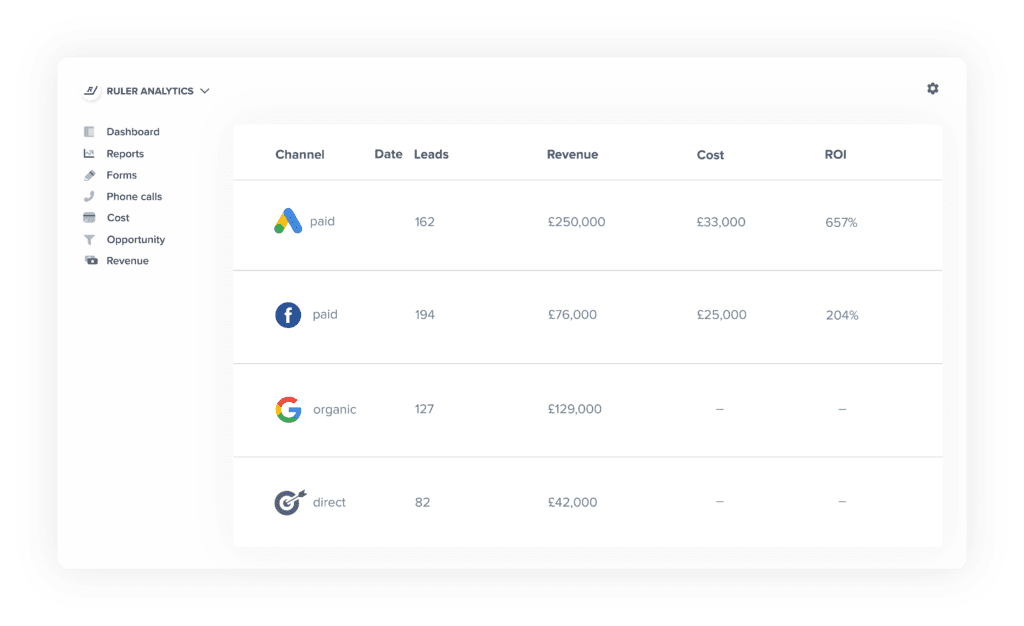
👉 Book a demo now to see the data in action
Do you use any offline marketing channels, like TV or print? These can be hard to track success. And, it’s even harder to understand how they impact customer journeys.
Plus, with conversion types like phone calls, it can be hard to link new leads back to your marketing campaigns.
In fact, 62% of marketers who use phone calls as a conversion tool said they struggled to track them.
With marketing attribution, you can better measure your offline marketing campaigns and you can attribute revenue back to them.
With marketing attribution, you can start to interpret your customer journey data to find micro conversions.
This could be that you find those who view a blog and are then retargeted are most likely to convert. Using attribution data against your customer journey is a great way to optimise your marketing and get your team working smarter, not harder.
Like with anything, attribution has perceived pitfalls and challenges. Some marketers swear by attribution, some swear by intuition.
We spoke to marketers to ask what they found to be their biggest challenges with marketing attribution. Read more on what they said in our complete blog of marketing attribution statistics. Or, view the chart below.
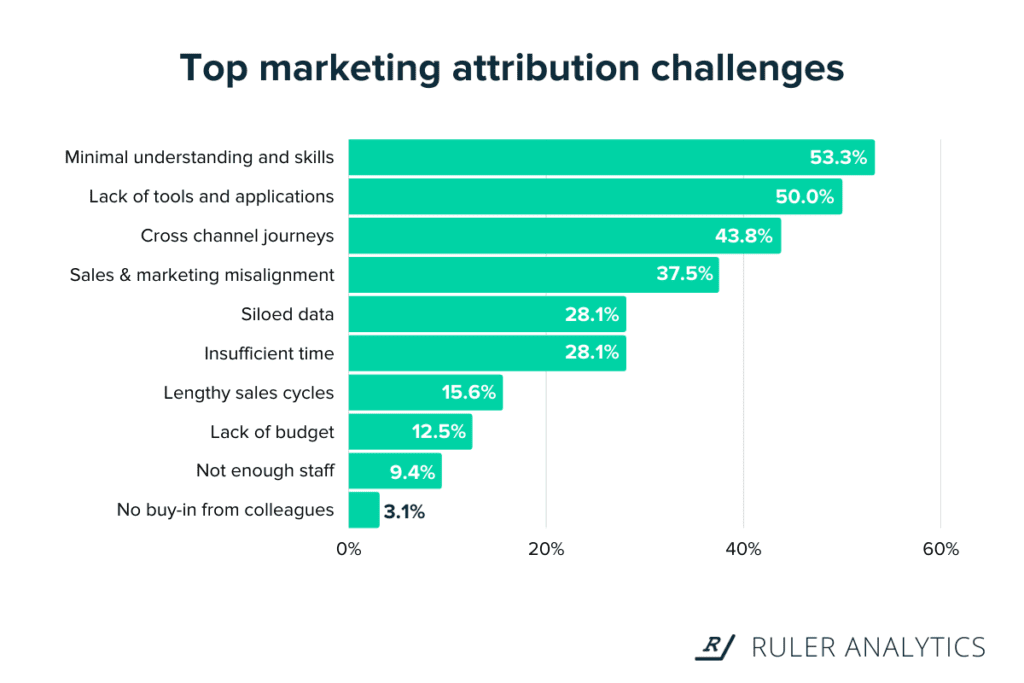
Attribution provides you the data you need to make smart, data-driven decisions but there’s no reason why you can’t test something you believe will work. With attribution in place, you can quickly assess how well it’s performing.
Related: Data-driven marketing, a complete guide
Some common challenges include:
Many marketing attribution tools focus on collecting data for online marketing channels. And for good reason. This is often where the main difficulty lies in establishing ROI and these channels can be difficult to get budget sign off on. Traditional marketing channels don’t tend to have such difficulties, but the same issues persist.
Many marketing attribution tools will completely omit offline marketing meaning your results aren’t accurate and you’re left with a huge data gap in your reporting.
✏️ Note
Ruler Analytics can connect offline marketing efforts to your online marketing. Read more about offline conversion tracking and how we do it, here 👉 Book a demo now to see the data in action
Many marketing attribution tools simply provide raw data for first and last-click attribution. But what does it actually mean for your customer journeys? Without a clear end to end understanding of your marketing, you’re going to struggle to use that data to improve your impact.
✏️ Note
Ruler Analytics offers customer journey tracking. You can track each and every touchpoint in Ruler and see full customer journeys.
Some may say that attribution is biased, whether that’s in-market or correlation bias. As such, it would mean predictions can be inaccurate.
In actual fact, attribution provides clear, raw data in-app. While you might not want to use attribution as gospel for every optimisation, it’s still hugely beneficial to use it as a guiding light.
So now we know more about what marketing attribution is and how it works, but how do you actually use it?
Well, there are a bunch of different marketing attribution model types to consider. From the popular first and last-click to the more advanced custom attribution model types.
We’ll walk you through each type and how to use them.
Marketers generally measure metrics like clicks, impressions, likes etc. The issue with these metrics is that they only highlight the potential of your marketing. To measure your marketing attribution, you need to measure your leads, conversions and most importantly, your revenue.
By tracking metrics like revenue you can see just how your marketing helps to generate more for your bottom line. Implementing a marketing attribution model will help you evidence that.
An attribution model is a rule (or set of rules) that determines how credit for sales and closed revenue is assigned back to touchpoints in the buyer’s journey.
Related: What is attribution modelling and how to get started
The first distinction to make when it comes to marketing attribution models is that there are two main types. Single-touch and multi-touch. Let’s go through them one by one.
First up is single-touch attribution models. It’s pretty much what it sounds like, but we’ll explain anyway.
With these attribution model types, 100% of the credit of a sale is credited to one touchpoint only. There are two types of single-touch attribution models.
Again, it’s what it says on the tin. In this attribution model type, all of the credit of a sale is credited to the very first touchpoint a user had that led them to your website.
Related: What is first-click attribution? A completed guide

So, if a user sees a PPC ad for your company and clicks on it, all of the credit would be assigned to that PPC campaign. Even if you later took out a social ad which caused the user to convert.
From a ROAS perspective, this is great, but what about the touchpoints that led that user through their customer journey? And what about the social ad which drove the user to convert? With first-click attribution, these steps aren’t counted.
Last-click attribution is another popular form of marketing attribution in which all of the credit is assigned to the very last touchpoint a user has before becoming a customer.
Related: Marketers guide to last-click attribution

So, in the same example as before, all of the credit would go to the social ad that converted the user.
But again, the PPC ad would be missed, along with the other steps that drove the user through their customer journey. As you can see, there are some issues with single-touch attribution alone.
If we think back to how long our customer journeys are then it becomes clear that first-click only gives a very small part of the data.
However, if you’re looking to see what content and campaigns are driving awareness, then first-click is a great model.
And, if you’re looking to find out what content and campaigns are helping to convert users, then last-click is very effective.
Now that we know about single-touch attribution models, let’s look into the different multi-touch attribution models.
Conversely to single-touch attribution model types, multi-touch attribution models split credit between multiple touchpoints in your buyer’s journey based on predetermined rules.
Related: What is multi-touch attribution and how to get started
The split given to credit is decided by the attribution model type you choose.
So, let’s look at each of them in a bit more detail.
First up, we have the linear attribution model. This model type assigns an equal split of credit to every touchpoint a lead has engaged with within their buyer’s journey.
Let’s use an example journey.
A user clicks a Google ad and visits your site for the first time. They then search your brand 3 days later and sign up to your newsletter. They revisit via an email campaign a few days later.
Finally, they convert into a sale via a direct search.
Using linear attribution, each touchpoint would receive 25% of the credit.

This is a great choice if you want to measure your campaigns holistically and get more data on which channels are appearing more frequently in the customer journey.
Next up is the U-shaped attribution model.
U-shaped or Position-based attribution gives the majority of credit to the first touchpoint and the touchpoint where the user became a qualified lead. In our example, the Google Ad and direct search would both receive 40% of the credit, while the rest of the credit would be split between the remaining touchpoints.

This attribution model will tell you which marketing channels are best for acquiring an audience and which are best for converting that audience.
Very similar to the U-shaped model is the W-shaped attribution model
This model type gives 30% to the first touchpoint. Another 30% is assigned to the touchpoint where a user becomes a qualified lead. A final 30% is assigned to the final touchpoint where the lead becomes a customer.
The remaining 10% is assigned evenly to remaining touchpoints. In our example, the Google Ad, the organic search and the direct search would each receive 30% of the credit. The final 10% would be assigned to the email campaign.

Next, we have the time decay model.
Time-based attribution assigns more weight to interactions that happen near the final conversion event. Using the same example as before, this model type will assign more credit to the direct search than it will to the Google Ad search.
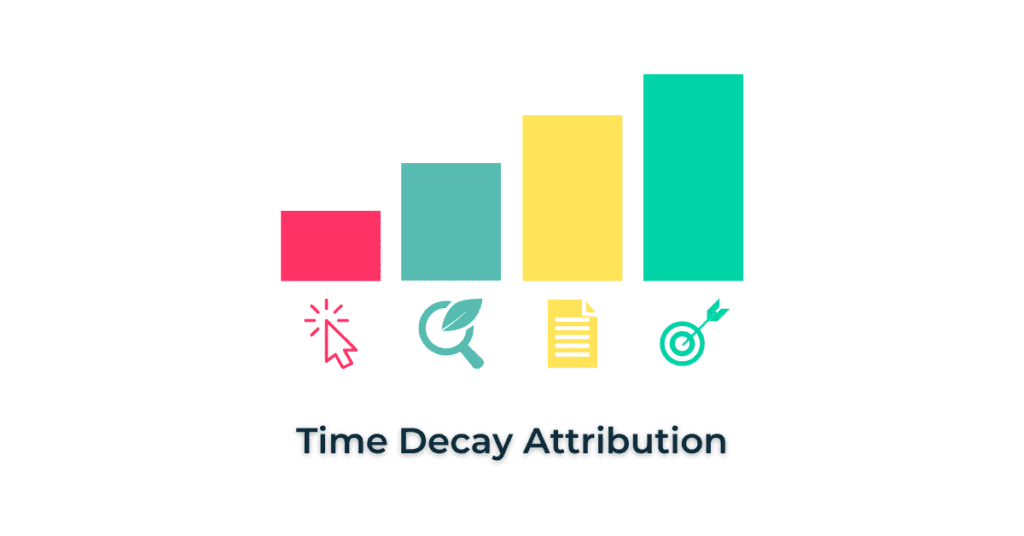
This attribution model is great for determining which channels regularly drive conversions and which are primarily top-of-funnel channels. Once you have that insight, you can spend more time and resources into using each channel to be its most effective.
One thing to bear in mind with this attribution model is that if you have a long sales cycle, then earlier touchpoints that were crucial in getting a user to consider your solution will be given very little credit.
In this model type, 22.5% of the credit is given to four touchpoints:

The remaining 10% is assigned evenly to the rest of the touchpoints in the buyer journey. Our example is a short journey so it looks identical to linear attribution.
Last but not least is the custom attribution model
The custom model is exactly what you would expect. You assign a chosen weighting to each touchpoint yourself depending on how important it is to your business.
If you have the resources, this is arguably the most effective way to attribute conversions to your entire marketing funnel, as you can tailor it to your exact needs.
And there you have it. All of the attribution models available to you with marketing attribution.
But, how do you decide which attribution model type to choose?
When you’re using so many different channels, online and offline conversions and running different campaigns, you have access to a huge amount of data.
Correlating and interpreting that data is a huge task though.
That’s where attribution comes in and hopefully, makes your job ten times easier.
Now you know each of the model types, what each one is good for and how to use each to maximise your marketing strategy. But that’s only half the battle, isn’t it?
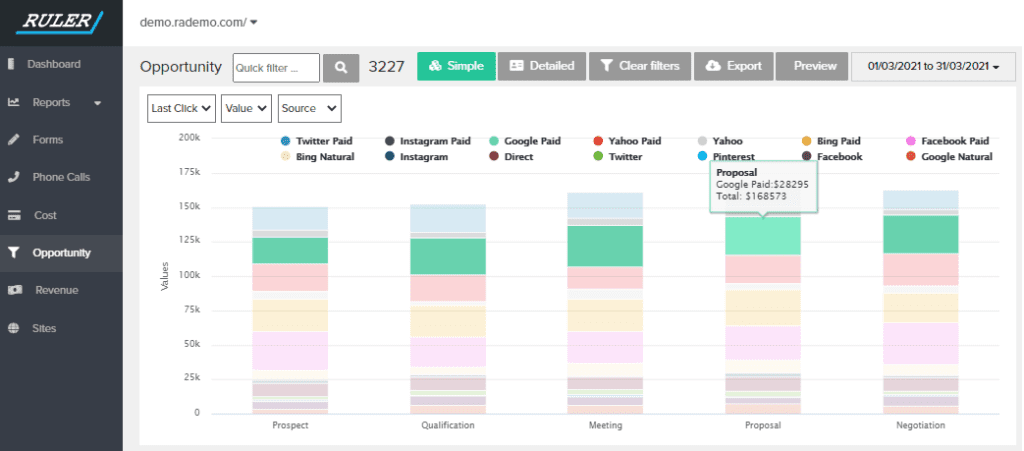
Choosing the right one is the crux of the issue. But remember, you’re not tied in. Play with different attribution model types and see which one works best for you.
While some marketers will swear by a particular model type, that doesn’t mean you should alter how you work to make that model type work for you.
Ask yourself this: what is the end goal of my marketing campaigns? And, which attribution model will help me to measure them more easily?
Plenty of marketers use single-touch attribution. There’s nothing wrong with using first or last-click attribution to measure your marketing effectiveness.
If you want to understand which channels are helping to begin or end customer journeys then they’re the perfect choice for marketing attribution.
If you want to go beyond single-touch attribution, then it can be hard to know which multi-touch attribution model to choose.
Custom, if feasible, is a dream as you can plot it how you want. But, it’s difficult to set up and it relies on you already having good insight into your average customer journeys.
Some things to consider are:
Answering these questions will help to illustrate which model type will work best for your business.
🚀 Pro Tip
Remember, it can be difficult to track and correlate lots of offline marketing activities. Read our guide on marketing mix modelling to understand how this can help you better understand your marketing activity.
Here is our summary of each attribution model type and what it’s best for:
First-click: Understand which channels are driving traffic of converting users
Last-click: Understand which channels are working best to convert users in your customer journey
Linear: Gather data on which channels are most commonly found in your customer journeys
U-shaped: Learn which channels are driving new converting customers and which channels are driving conversions
W-shaped: Learn which channels are driving new converting customers, which help drive leads and which then drive final conversions. Not suited for those in B2C.
Time Decay: Determine which channels regularly drive conversions and which are primarily top-of-funnel channels
Full Path: Understand which channels are encouraging key actions
Got a better idea of which attribution model you want to test out?
Take a look at some of the top picks for marketing attribution tools here. But we’ll save you some reading because Ruler Analytics comes out top of that list. Find out exactly how Ruler attributes your revenue to your marketing. Or, book a demo to see the data in action.
